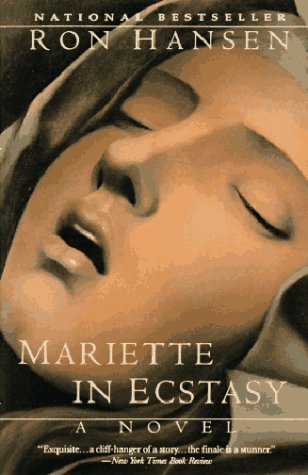Mariette in Ecstasy

This little book, by Ron Hansen, is a story of a small community of cloistered nuns during the early 1900s who are about to face their greatest challenge. Their typically quiet, simple lives are turned upside down when a young novice, Mariette, joins them and claims to have had a vision of Jesus. To some she seems a saint growing before their eyes, to others she is a deceitful flirt who takes pleasure in the attention her holiness garners. Which side of her do you see as you read the story? That is the question the author leaves his readers.
I first heard about this book when I read a blog post on A Nun’s Life about a local theater group who performed the book as a play. It sounded interesting, so I jumped on Amazon immediately to buy a copy. I was a little upset they had no Kindle version, but I made due with the paperback. Besides, now I have a book to give away to someone else who wants to read it. Maybe Kenn.
Now before I begin critiquing the book, let me first say that it was a wonderful story. The characters had a life to them and there was an element of truth to both points of view. Mr. Hansen seems to have a wonderful writing talent and some of his imagery was almost poignant. All-in-all, the book was a great success, and I’m glad I read it.
There were, however, a few things that bothered me a great deal. The first is a general complaint about a lot of modern writers I’ve read recently. Several times throughout this book, Mr. Hansen chose to describe a scene and create a sense of emotion by the way his sentences were displayed rather than with their content. I accept that sentence structure can play an important role in the pacing of the story, but taken to this extreme it reminded me of a similar practice in Cormac McCarthy’s The Road. With the sentences written in near bullet-points, the stacatto rhythm was meant to convey a sense of silence, tranquility, and serenity, but with an undercurrent of tension. It does accomplish its task, but the cost to me as a reader is huge. The writing style also serves to take me completely out of the story, becoming more aware of the words on the page and less aware of the scene as a whole. It leaves me wondering why these authors, who are incredibly talented and can write amazing descriptive scenery, are flocking towards tricks of formatting. More than anything, I feel as if the style robbed me of a great wealth of description. Even now, after having read the book, while i can picture a few main characters and a room or two, I’m at a general loss for what the rest of the world looks like. While the moral and religious conflicts may stick with me for a time, I’m certain that I will have soon forgotten any imagery herein.
Finally, I must protest about the ending. Perhaps it is the American in me, but I wanted more resolution. I understand that the book had to keep things up in the air, and I’m fine with that, but the way the ending played out seemed less to bring the tension to a head than it did to deflate it and fizzle away. I’ll leave my complaint on this point with that statement. Anything more may spoil the reading experience for others.
So, in closing, I would recommend this book to anyone interested in the subject matter. If you’re not enticed by the wonders of cloistered life or the mystery of a religious calling, or if you think a story about a nun who may or may not have had a visitation from Christ is not very interesting, you’ll want to pass this one by. Enjoy!